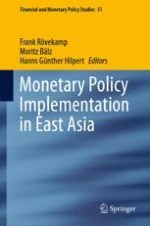2020 | OriginalPaper | Buchkapitel
2. China’s Monetary Policy: Institutional Setting, Tools and Challenges
verfasst von : Patrick Hess
Erschienen in: Monetary Policy Implementation in East Asia
Aktivieren Sie unsere intelligente Suche, um passende Fachinhalte oder Patente zu finden.
Wählen Sie Textabschnitte aus um mit Künstlicher Intelligenz passenden Patente zu finden. powered by
Markieren Sie Textabschnitte, um KI-gestützt weitere passende Inhalte zu finden. powered by
